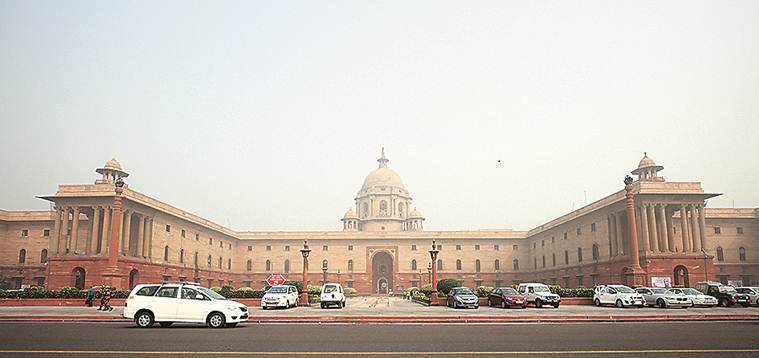
In the Capital’s history, few architectural projects have been as divisive as this one. On September 13, the Ministry of Housing and Urban Affairs (MoHUA) announced the “PM’s dream project” — the ambitious redevelopment of Lutyens’ Delhi. While some fear the project will hurt the city’s heritage and the 2024 deadline might hasten work that deserves more time, others believe the redevelopment will give the Central Vista — the area from the Rashtrapati Bhawan to India Gate — much-needed change and modernisation, albeit with an “Indian ethos”.
In fact, the last time battle lines were drawn over buildings was in the 1920s, when architects of New Delhi, Edwin Lutyens and Herbert Baker, disagreed over the height of the Rashtrapati Bhawan and the North and South Block buildings. The disagreement ended an old friendship.
A week before architectural firms deposit their bids for the project, The Indian Express looked at the history of the Central Vista and spoke to historians, architects and stakeholders about apprehensions and challenges ahead, and what New Delhi could look like in 2024.
At the coronation of George V as Emperor of India on December 12, 1911, he had announced, “We have decided upon the transfer of the seat of the Government of India from Calcutta to the ancient Capital of Delhi.” And thus began a 20-year-long project spearheaded by Lutyens and Baker, who built Parliament House, Rashtrapati Bhawan, North and South Blocks, Rajpath, India Gate, National Archives and the princes’ houses around India Gate. New Delhi was unveiled in 1931.
About the redevelopment project, Najaf Haider, professor of History at JNU, said, “The history of modern India has always been of a dynasty building a new city. I see this project as the present government establishing its own regime.”
Interview | The Bhawans will go… they are in such poor state: Union Minister Hardeep Singh Puri
The Central Public Works Department, which will supervise the project, has invited bids from architectural firms for this. A senior CPWD official said, “The facade of the Rashtrapati Bhawan, the North and South Blocks and Parliament will not be touched because of their heritage value. Inside, changes will be made and we will see if the Parliament will be used for the same purpose or not.” By Diwali this year, the CPWD will announce the firm that will be handed over the project.
Senior architect Ranjit Sabikhi said, “Since the ’60s, the population of Delhi has multiplied manifold, and there are very few public spaces left. I accept the offices need more space, but there is plenty of land across Delhi lying empty; they can build it there as well.”
Historian and INTACH co-convener Swapna Liddle said attention should be given to the “line of sight and any new construction shouldn’t hurt the Lutyens’ symmetry”. “The Bhawans reflect post-Independence austerity and were caught between the Lutyens’ style and the Modern movement… Some can be done away with, except the Vayu and Rail Bhawans, which are pretty decent,” she said.
North and South Block Buildings

World War I was a roadblock in the construction of New Delhi and work slowed down on the Secretariat buildings (now called North and South Blocks). While the Blocks, designed primarily by architect Herbert Baker, were being built in 1915, Edwin Lutyens pointed out that the view of the Government House or Rashtrapati Bhawan will be obstructed. This led to an old friendship between Baker and Lutyens turning sour. By 1925, the Blocks were partially ready and “several departments started moving into the buildings… by November 1926, the buildings were fully functional even though the domes were yet to be built,” said Liddle. In 1930, the Blocks were ready
Vigyan Bhawan

Rashtrapati Bhawan

Designed by Edwin Lutyens, it was first called Government House, and in December 1929, when Viceroy Irwin moved there (even though some electrical work was pending), it came to be known as Viceroy House. Work on it started alongside the North and South Blocks, but several roadblocks, including World War I, scanty stone supply, and a Lutyens-Herbert Baker disagreement led to delay in completion. Four wings of the Government House were completed and the dome was built in 1928.
Parliament House, Parliament Library Building

The Parliament House was not a part of the original plan, and in 1921, work on a new “Legislative building” began, historian Swapna Liddle said. It was designed by Herbert Baker and formally inaugurated in January 18, 1927. Behind it, the library was added to the Central Vista in 2003, built by famous architect Raj Rewal. “It doesn’t disturb the symmetry of the Central Vista… if you see the Parliament from Vijay Chowk, you can’t see the library,” said Liddle.
Hyderabad & other Houses
Around India Gate were built house of various “princes”, and Edwin Lutyens was the architect of the Hyderabad House and Baroda House. In 1928, Hyderabad House and Bikaner House were inaugurated. In 1931, when New Delhi was finally unveiled, Baroda House and Travancore House were under construction. The other houses followed Lutyens’ style of architecture. In her book, Connaught Place and the Making of New Delhi, Liddle writes, “One category that occupied a special racial and class position was that of the ‘native princes’… after planning of the new city began, the princes began to make applications to be allotted land in the new Capital.”
According to the CPWD, the North and South Blocks are not earthquake-safe and will be fixed using advanced technology, as it was done with the New Zealand Parliament. While the iconic Lutyens and Baker buildings will stay, Rajpath is expected to undergo major changes and the Bhawans, built by the CPWD in the late ’50s and early ’60s, are likely to be demolished